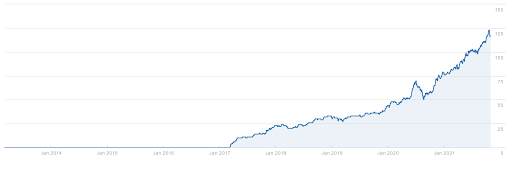Oh Christmas Tree… Embracing Evergreen Tactics for the Sales and Holiday Season
Using a well-known tactic in search strategy, you can make small changes to your Black Friday and Boxing Day sales this season that could pay it forward for years to come.
Your team has probably been planning content for the upcoming festive sales season for months. But before you hit publish on those landing pages, you might want to check whether strategic thought has gone into where that content is being published to exactly.
We’re talking about the URLs here—the web addresses on which that seasonal promotional content will live and to which all ad campaigns will point.
There are three broad approaches for hosting seasonal content:
1. Creating a completely new and unique URL, often informed by the main heading on the page:
Last year: /black-friday-sale
This year: /black-friday-deals
2. Creating new pages in a sequence, for example:
Last year: /black-friday-2020
This year: /black-friday-2021
3. Reusing the same URL year-on-year, only updating the content.
All three approaches will deliver sales if your marketing team is running paid campaigns, sending email traffic and directing social engagement to those pages.
But only the last one is likely to deliver substantial organic (free!) traffic, often steadily increasing year-on-year.
This principle is known as evergreen content and is a well-used technique in SEO and content marketing to steadily grow organic traffic for timeless content.
What’s less known is that with a few tweaks and some imagination, the same principle can be applied to repeating seasonal content with similarly successful outcomes.
Channelling the spirit of the Christmas tree, now is a great time to start thinking about evergreening your sales-season content.
What is evergreen content?
As the name suggests, evergreen content covers a topic that stays highly relevant to its audience, regardless how much time passes. That could be because it’s a discussion of a fundamental scientific truth, a comprehensive guide for walking the Santiago de Compostela, or the recipe for boiling an egg.
When this content is posted online, as there is persistent search interest in the subject, it will usually continue to get a steady stream of organic traffic which often increases over time.
This stands in stark contrast to most online content which has a short shelf life, written to report a news event, sports result, comment on a trend or share an offer. After an initial peak in interest, visits peter out and traffic eventually flatlines.
Why evergreen content works
Because it stays relevant in perpetuity, evergreen content accumulates backlinks—referral links from other websites and platforms. This builds the content’s authority over time, causing it to rise to the top of the search rankings where it attracts more traffic.
The graph below charts the steady rise in referring pages (other websites) linking to a detailed guide on the correct placement of area rugs:

These are the backlinks that are effectively “thrown away” when we create new pages for seasonal offers every year. For evergreen pages that are kept live like this one, this steady growth in backlinks leads to a rise in search rankings as it becomes increasingly visible for keywords. As a result, search traffic increases in step:

Fad-based content, on the other hand, stops attracting backlinks as it becomes dated, as is the case for this article on 2019 colour trends:

Rankings slip and traffic declines as visibility erodes and consumer interests move on to the next season.

Most evergreen content requires planning and maintenance
Weighing the returns on evergreen vs short-term content, the former clearly seems a much better content investment—promising compound interest over time. But these two content types differ significantly in their production and maintenance costs and in most cases can’t be considered like-for-like.
Most evergreen content requires planning and research. It’s necessary to have a solid grasp of the popularity of the topic and the vocabulary that is used to search for it. SEO-based keyword research can support this approach. Good evergreen content is also comprehensive (read: long) and contains a variety of media—compelling images, graphics, and lately, video.
Trend-based content on the other hand, can often be written without much consideration of search demands and usually, by its nature is shorter.
Once it’s launched, evergreen content will also require some maintenance to keep it current. The context may change, the field evolves, or formats for content delivery could advance requiring images in a new format, higher resolution video etc.
When the content is kept fresh, Google and other search engines are further reassured that it is up to date and can continue to be relied upon to provide searchers with the answers they need.
A robust content plan takes these considerations into account and will allocate appropriate resource for the production of evergreen content alongside shorter-lived content.
Evergreen-ing outdated content
But even if evergreen content hasn’t been part of your content strategy to date, you may have produced content in the past that can be adapted to become evergreen.
It’s likely the content you’ve invested in most has the highest potential for evergreening. Detailed guides, industry commentary and whitepapers may all discuss the state of affairs at a particular point in time, but could they be reviewed and updated to renew the interest they once generated?
Applying the same process required to engineer and maintain evergreen content: conducting keyword research to establish the vocabulary currently driving interest in this topic and refreshing the content with up-to-date research and commentary, can return it to its former state of visibility and once again drive leads.
Transforming seasonal content into evergreen content
If you can dust off older content to refresh it, you can also take steps to make seasonal content more timeless.
By keeping to one URL for each seasonal offer and committing to a schedule of content updates informed by SEO research to keep the content relevant to your audience, you can maintain the same page and build authority and organic visibility over time.
A step-by-step guide to evergreening your seasonal content
1. Audit your URLs
Start by taking stock of the URLs your marketing team is planning to use this year. Are they different from the year before? Do you know which URLs were used last year? And/or the year before?
Carry out a quick backlink audit on all past URLs to assess the quality of the links pointing to them. Consider reusing one of the past URLs if it has a strong backlink profile.
If you are moving on to a new URL, ensure all past ones are redirected appropriately to the latest page.
2. Settle on a fixed URL
Decide on a URL that is timeless. Don’t include a date or any other content that might age and require updating.
3. Plan for the evolution of your content
What will you do with the content during the times of the year when the offers are not valid? Argos uses its /black-friday page to remind searchers of the date and give them tips for preparing for the sale.

Your content could refer visitors to other seasonal sales or share an article or guide about something that is at the heart of your brand.
Get everyone on board
This strategy only works when everyone is informed and knows about the vision going forward. Ensure the strategy is communicated with all teams who work on the web and are building landing pages for campaigns.
Beyond the sales season
Not doing sales? Adopt this strategy for any content that comes in and out of season. Do you have an autumn catalogue that generates a good deal of interest every year? Consider hosting it on a fixed URL like /autumn-catalogue and archiving past editions to a sub-folder, like: /autumn-catalogue/2021.
Or perhaps your company has an annual Christmas message that is often linked to by partner brands? Retain the same URL, update the content and appropriately file away past messages in a similar fashion.
If you are ready to start exploring ways of getting more return on your content and marketing investment, including evergreening your existing content and developing strategies to create or evergreen content, get in touch to chat to our team about our SEO and content marketing services.




